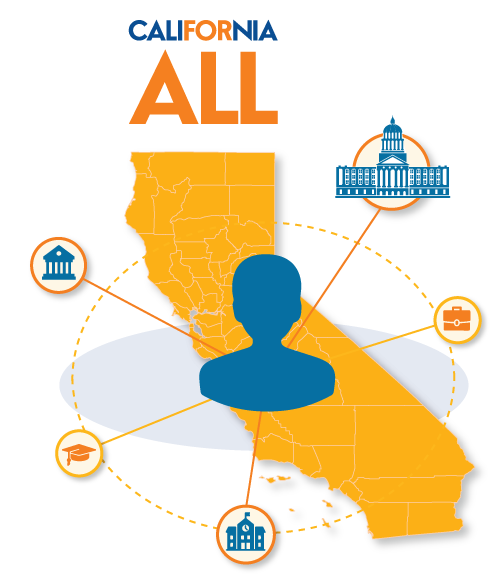—ECOSYSTEM
A System for Success
Almost three million students enroll in higher education in California each year. In pursuit of a degree, the average student attends more than one institution, sometimes at the same time. Many more students aspire to attend college, and some students face extraordinary barriers to successful entry, transitions, and attainment. All are our students, and to serve them well and fulfill our promise to the people of California, we need to develop a cohesive system that provides a seamless experience for students that expands access and increases degree attainment.

The California Governor’s Council for Post-Secondary Education sees success in a shared approach to capacity across systems that will translate into opportunity for students across the state.
Higher Education

California Community Colleges provide an accessible on-ramp to higher education and career advancement through the pursuit of relevant coursework and associate’s degrees. Two million students attend these 116 networked campuses across the state.

The California State University system, with its 23 campuses, serves one of the most diverse student bodies in the United States. Nearly 500,000 students attend CSU institutions in pursuit of bachelor’s and graduate degrees.

The University of California system is a world-class public research university granting degrees in bachelor’s and graduate studies. Its 10 campuses serve almost 300,000 students each year.

The Association of Independent California Colleges and Universities (AICCU) comprises 85 independent, nonprofit colleges and universities, which make up the Independent California Colleges and Universities (ICCU) sector. Within California, ICCU institutions award 20% of all bachelor's degrees, and more than half of all graduate degrees, making them the largest preparers of California's advanced workforce.
Government

The California Governor’s Office established the Council for Post-Secondary Education and prioritizes education as a means for advancement and innovation across the state. See the higher education chapter of Governor Gavin Newsom’s budget.

The California Legislature processes more than 6,000 bills each two-year session to shape life in California. Its committees for higher education, K-12 education and workforce development have a special responsibility to ensure our education systems serve Californians and our shared future.

The California Department of Education (CDE) oversees the state's diverse and dynamic public school system, which is responsible for the education of more than seven million children and young adults in more than 9,000 schools.

The California State Board of Education is the governing and policy-making body of the California Department of Education. The State Board of Education sets K-12 education policy in the areas of standards, instructional materials, assessment, and accountability.

The California Student Aid Commission (CSAC) administers financial aid programs for students attending public and private universities, colleges, and vocational schools in California. The Commission serves as a resource for policymakers and the public on college affordability and financing issues, and advocates for policy changes to eliminate cost as a barrier to higher education.
Related Initiatives

The Future of Work Commission is developing a new social compact for California workers, based on an expansive vision for economic equity that takes work and jobs as the starting point.

The Longitudinal Data System intends to link data systems across segments to allow for cradle-to-career tracking of student outcomes—providing insights that can help guide development of more effective educational policies and set funding priorities.

The Task Force on Business and Jobs Recovery was convened to advise the administration on rebuilding as quickly and safely as possible from the pandemic-induced recession while working towards an equitable, clean, and prosperous future. See the Task Force’s final report (PDF).

COVID19.ca.gov provides guidelines and considerations to help institutions of higher education (IHE) and their communities plan and prepare to resume in-person instruction. View COVID-19 guidance (PDF).


